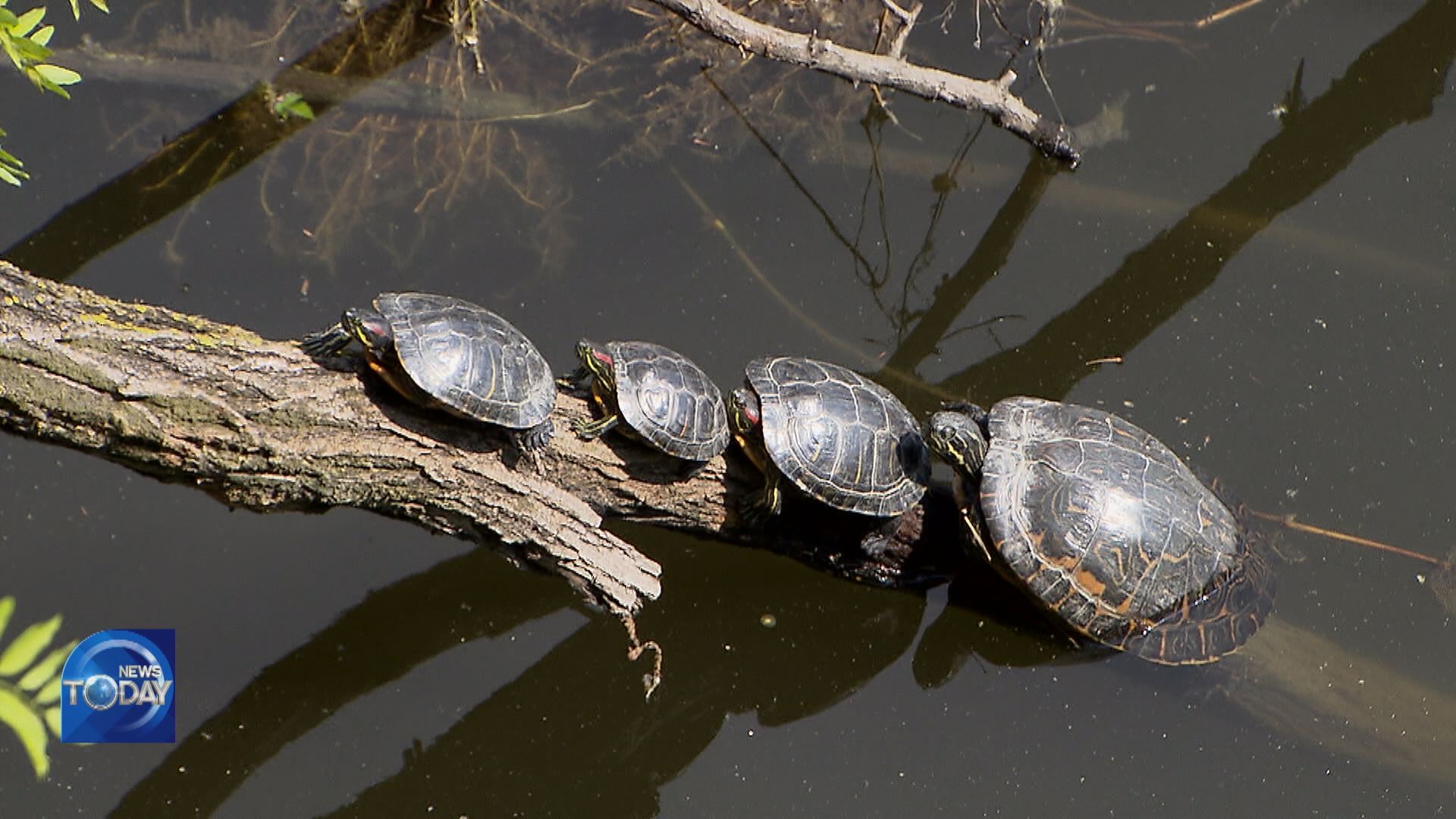RED-EARED SLIDER DISRUPTS ECOSYSTEM
입력 2022.05.16 (15:13)
수정 2022.05.16 (16:45)
읽어주기 기능은 크롬기반의
브라우저에서만 사용하실 수 있습니다.
[Anchor Lead]
The red-eared slider featuring a red stripe on each side of its head is classified as an ecosystem-disrupting invasive species together with the nutria or American bullfrog. Originating from the southern regions of the United States, red-eared terrapin colonies have been spotted recently in the upstream Han River that runs through urban areas.
[Pkg]
This is the Gonjicheon stream that runs through the city of Chuncheon in Gangwon-do Province. Several turtles are enjoying the sun on a fallen log. They are all red-eared sliders. They are often caught by fishermen.
[Soundbite] Park Eun-su(Fisherman) : "I’ve seen them a lot since I fish here frequently with my friends. There have been lots of turtles here but I’m surprised to have caught some."
The red-eared terrapin was designated an invasive species that disrupts the local ecosystem back in 2001 after they had replaced the indigenous pond turtle. It was initially brought into Korea as a pet in the 1990s. But the turtles entered the local ecosystem when they were abandoned or released in the water for religious events When fully grown, it measures nearly 60 centimeters. It reproduces fast as it lays about 10 eggs a year and hardly has any natural enemies.
[Soundbite] Choi Wu-jin(Herpetology Research Lab, Kangwon Nat’l Univ.) : "They are an omnivore that feed on fries, crustaceans, gastropods, water plants and tree leaves. They disturb the creatures and plants in the hydro-ecosystem."
Colonies of red-eared sliders have been spotted living in urban rivers in the uppermost areas of the Hangang River, but no studies have been done on their habitats yet.
The red-eared slider featuring a red stripe on each side of its head is classified as an ecosystem-disrupting invasive species together with the nutria or American bullfrog. Originating from the southern regions of the United States, red-eared terrapin colonies have been spotted recently in the upstream Han River that runs through urban areas.
[Pkg]
This is the Gonjicheon stream that runs through the city of Chuncheon in Gangwon-do Province. Several turtles are enjoying the sun on a fallen log. They are all red-eared sliders. They are often caught by fishermen.
[Soundbite] Park Eun-su(Fisherman) : "I’ve seen them a lot since I fish here frequently with my friends. There have been lots of turtles here but I’m surprised to have caught some."
The red-eared terrapin was designated an invasive species that disrupts the local ecosystem back in 2001 after they had replaced the indigenous pond turtle. It was initially brought into Korea as a pet in the 1990s. But the turtles entered the local ecosystem when they were abandoned or released in the water for religious events When fully grown, it measures nearly 60 centimeters. It reproduces fast as it lays about 10 eggs a year and hardly has any natural enemies.
[Soundbite] Choi Wu-jin(Herpetology Research Lab, Kangwon Nat’l Univ.) : "They are an omnivore that feed on fries, crustaceans, gastropods, water plants and tree leaves. They disturb the creatures and plants in the hydro-ecosystem."
Colonies of red-eared sliders have been spotted living in urban rivers in the uppermost areas of the Hangang River, but no studies have been done on their habitats yet.
■ 제보하기
▷ 카카오톡 : 'KBS제보' 검색, 채널 추가
▷ 전화 : 02-781-1234, 4444
▷ 이메일 : kbs1234@kbs.co.kr
▷ 유튜브, 네이버, 카카오에서도 KBS뉴스를 구독해주세요!
- RED-EARED SLIDER DISRUPTS ECOSYSTEM
-
- 입력 2022-05-16 15:13:15
- 수정2022-05-16 16:45:10

[Anchor Lead]
The red-eared slider featuring a red stripe on each side of its head is classified as an ecosystem-disrupting invasive species together with the nutria or American bullfrog. Originating from the southern regions of the United States, red-eared terrapin colonies have been spotted recently in the upstream Han River that runs through urban areas.
[Pkg]
This is the Gonjicheon stream that runs through the city of Chuncheon in Gangwon-do Province. Several turtles are enjoying the sun on a fallen log. They are all red-eared sliders. They are often caught by fishermen.
[Soundbite] Park Eun-su(Fisherman) : "I’ve seen them a lot since I fish here frequently with my friends. There have been lots of turtles here but I’m surprised to have caught some."
The red-eared terrapin was designated an invasive species that disrupts the local ecosystem back in 2001 after they had replaced the indigenous pond turtle. It was initially brought into Korea as a pet in the 1990s. But the turtles entered the local ecosystem when they were abandoned or released in the water for religious events When fully grown, it measures nearly 60 centimeters. It reproduces fast as it lays about 10 eggs a year and hardly has any natural enemies.
[Soundbite] Choi Wu-jin(Herpetology Research Lab, Kangwon Nat’l Univ.) : "They are an omnivore that feed on fries, crustaceans, gastropods, water plants and tree leaves. They disturb the creatures and plants in the hydro-ecosystem."
Colonies of red-eared sliders have been spotted living in urban rivers in the uppermost areas of the Hangang River, but no studies have been done on their habitats yet.
The red-eared slider featuring a red stripe on each side of its head is classified as an ecosystem-disrupting invasive species together with the nutria or American bullfrog. Originating from the southern regions of the United States, red-eared terrapin colonies have been spotted recently in the upstream Han River that runs through urban areas.
[Pkg]
This is the Gonjicheon stream that runs through the city of Chuncheon in Gangwon-do Province. Several turtles are enjoying the sun on a fallen log. They are all red-eared sliders. They are often caught by fishermen.
[Soundbite] Park Eun-su(Fisherman) : "I’ve seen them a lot since I fish here frequently with my friends. There have been lots of turtles here but I’m surprised to have caught some."
The red-eared terrapin was designated an invasive species that disrupts the local ecosystem back in 2001 after they had replaced the indigenous pond turtle. It was initially brought into Korea as a pet in the 1990s. But the turtles entered the local ecosystem when they were abandoned or released in the water for religious events When fully grown, it measures nearly 60 centimeters. It reproduces fast as it lays about 10 eggs a year and hardly has any natural enemies.
[Soundbite] Choi Wu-jin(Herpetology Research Lab, Kangwon Nat’l Univ.) : "They are an omnivore that feed on fries, crustaceans, gastropods, water plants and tree leaves. They disturb the creatures and plants in the hydro-ecosystem."
Colonies of red-eared sliders have been spotted living in urban rivers in the uppermost areas of the Hangang River, but no studies have been done on their habitats yet.
이 기사가 좋으셨다면
-
좋아요
0
-
응원해요
0
-
후속 원해요
0

















이 기사에 대한 의견을 남겨주세요.